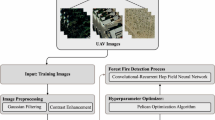Abstract
Collision avoidance for unmanned aerial vehicles is a main task for autonomous aerial systems. One of the major challenges facing such technology is the existence of a high level of uncertainty in moving objects. In this research study, we chose to work with object’s classification and probabilistic models to deal with the system’s uncertainty. First, a classification takes place through detecting an object, identifying it using a trained convolutional neural network, and analyzing its velocity. Afterwards, a Bayesian probabilistic model takes inputs of the detected object’s type, orientation, and velocity along with the host unmanned aerial vehicle’s velocity. It gives an output of the detected object’s space occupancy. The simulation results show that the space occupancy clearly changes with respect to the available inputs of the Bayesian model as a function of time; hence, optimizing the space occupancy around the detected object.
Similar content being viewed by others
References
Tomic, T., et al.: Toward a fully autonomous UAV: research platform for indoor and outdoor urban search and rescue. IEEE Robot. Autom. Mag. 19(3), 46–56 (2012)
Kim, Y., Jung, W., Bang, H.: Visual target tracking and relative navigation for unmanned aerial vehicles in a GPS-denied environment. Int. J. Aeronaut. Space Sci. 15(3), 258–266 (2014)
Price, A., et al.: Real time object detection for an unmanned aerial vehicle using an FPGA based vision system. In: Robotics and Automation (ICRA) (2006)
Jeon, B., et al.: Mode changing tracker for ground target tracking on aerial images from unmanned aerial vehicles, Control,Automation and Systems (ICCAS) (2013)
Kanellakis, C., Nikolakopoulos, G.: Survey on computer vision for uavs: current developments and trends. J. Intell. Robot. Syst. 87(1), 141–168 (2017)
Tijmons, S., et al.: Obstacle avoidance strategy using onboard stereo vision on a flapping wing mav. IEEE Trans. Robot. 33(4), 858–874 (2017)
Mcfadyen, A., Mejias, L.: A survey of autonomous vision-based see and avoid for unmanned aircraft systems. Prog. Aerosp. Sci. 80, 1–17 (2016)
Matthies, L., et al.: Stereo vision-based obstacle avoidance for micro air vehicles using disparity space. In: Robotics and Automation (ICRA). IEEE (2014)
Mullins, M., Holman, M.W., Foerster, K.M., Kaabouch, N., Semke, W.: Dynamic separation thresholds for a small airborne sense and avoid system. In: AIAA Infotech Aerospace Conference, p 5148 (2013)
Foerster, K., Mullins, M., Kaabouch, N., Semke, W.: Flight testing of a right-of-way compliant ADS-B-based miniature sense and avoid system. In: Infotech Aerospace Conference, p 2503 (2012)
Gellerman, N., Kaabouch, N., Semke, W.: A terrain avoidance algorithm based on the requirements of terrain awareness and warning systems. In: Aerospace Conference IEEE, pp 1–6 (2015)
Mullins, M., Foerster, K., Kaabouch, N., Semke, W.: Incorporating terrain avoidance into a small UAS sense and avoid system. In: Infotech Aerospace Conference, p 2504 (2012)
Shim, D.H., Chung, H., Sastry, S.S.: Conflict-free navigation in unknown urban environments. IEEE Robot. Autom. Mag. 13(3), 27–33 (2006)
Luo, D., et al.: Implementation of obstacle avoidance technique for indoor coaxial rotorcraft with Scanning Laser Range Finder. In: Control Conference (CCC), 31. IEEE (2012)
Shang, E., et al.: A novel setup method of 3D LIDAR for negative obstacle detection in field environment. In: Intelligent Transportation Systems (ITSC), 17. IEEE (2014)
Yu, T., et al.: Collision avoidance for cooperative UAVs with rolling optimization algorithm based on predictive state space. Appl. Sci. 7(4), 329 (2017)
Lin, Y., Saripalli, S.: Sampling-based path planning for UAV collision avoidance. IEEE Trans. Intell. Transp. Syst. 18(11), 3179–3192 (2017)
Lyu, Y., et al.: Vision-based UAV collision avoidance with 2D dynamic safety envelope. IEEE Aerosp. Electron. Syst. Mag. 31(7), 16–26 (2016)
Pierpaoli, P., Rahmani, A.: UAV collision avoidance exploitation for noncooperative trajectory modification. Aerosp. Sci. Technol. 73, 173–183 (2018)
Tutsoy, O., Barkana, D.E., Tugal, H.: Design of a completely model free adaptive control in the presence of parametric, non-parametric uncertainties and random control signal delay. In: ISA Transaction 76th. ELSEVIER (2018)
Gongor, F., Tutsoy, O.: Humanoid Robots Learn and Recognize Seven Facial Emotions with ANN. In: International Science and Academic Congeress, INSAC, p 18 (2018)
Elderini, T., Kaabouch, N., Reyes, H.: Outage probability estimation technique based on a bayesian model for cognitive radio networks. In: IEEE 7th Annual Computing and Communication Workshop and Conference (CCWC). IEEE (2017)
Willen, C., Lehmann, K., Sunnerhagen, K.: Walking speed indoors and outdoors in healthy persons and in persons with late effects of polio. J. Neurol. Res. 3(2), 62–67 (2013)
Author information
Authors and Affiliations
Corresponding author
Additional information
Publisher’s Note
Springer Nature remains neutral with regard to jurisdictional claims in published maps and institutional affiliations.
Rights and permissions
About this article
Cite this article
Elderini, T., Kaabouch, N. & Neubert, J. Space Occupancy Representation Based on A Bayesian Model for Unmanned Aerial Vehicles. J Intell Robot Syst 97, 399–410 (2020). https://doi.org/10.1007/s10846-019-01042-w
Received:
Accepted:
Published:
Issue Date:
DOI: https://doi.org/10.1007/s10846-019-01042-w




